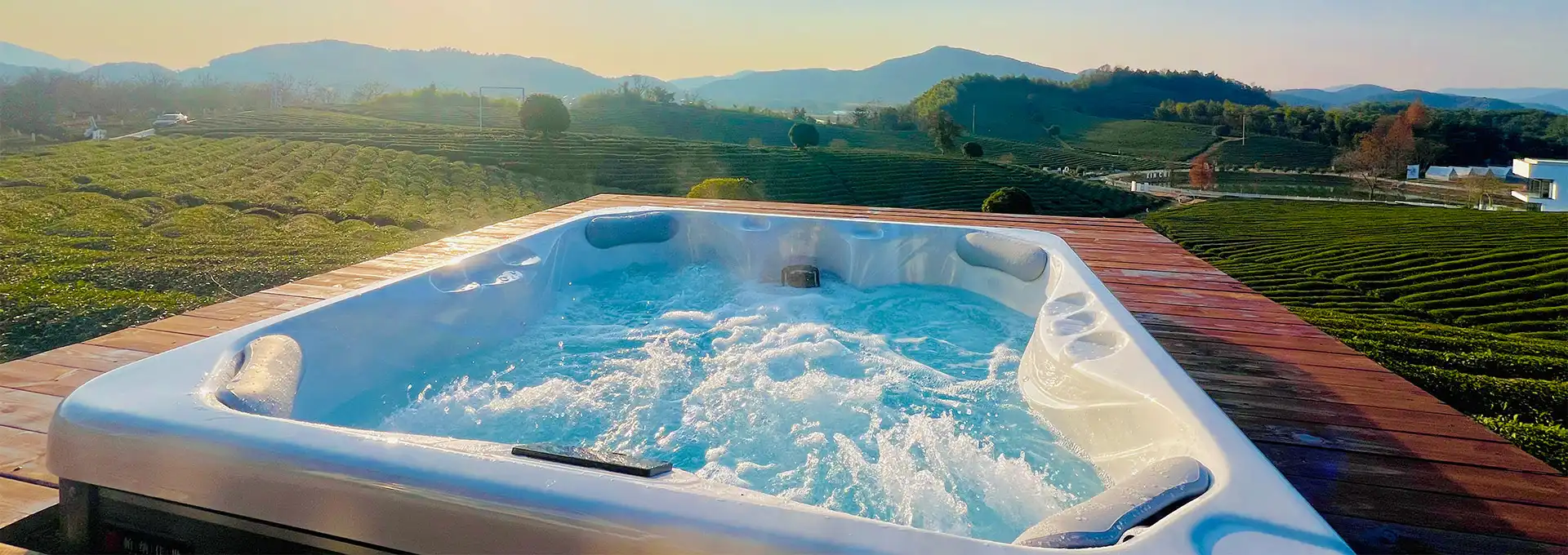Are 2-3 Person Hot Tubs Energy-Efficient? The Surprising Truth
2025-09-23 16:35:47
When it comes to relaxation and wellness, 2-3 person hot tubs have become increasingly popular among homeowners. These compact spas offer a perfect balance of comfort and convenience, fitting snugly into smaller spaces while still providing all the benefits of hydrotherapy. However, a common concern for potential buyers is the energy efficiency of these smaller units. In this article, we'll dive deep into the world of compact hot tubs and uncover the surprising truth about their energy consumption.
Comparing Energy Consumption: Small vs. Large Hot Tubs
At first glance, one might assume that larger hot tubs consume more energy than their smaller counterparts. While this is generally true, the relationship between size and energy consumption isn't as straightforward as you might think.
2-3 person hot tubs typically have a water capacity ranging from 150 to 300 gallons, compared to larger models that can hold up to 500 gallons or more. This reduced water volume means less energy is required to heat and maintain the water temperature. However, other factors come into play when determining overall energy efficiency.
Insulation plays a crucial role in energy consumption. Many modern compact hot tubs are designed with advanced insulation techniques, such as full-foam insulation or thermal barriers, which help retain heat more effectively. This means that once the water is heated, it requires less energy to maintain the desired temperature.
Additionally, the surface area-to-volume ratio of smaller hot tubs can work in their favor. With less exposed surface area relative to their water volume, compact tubs may experience less heat loss through evaporation and radiation. This can contribute to improved energy efficiency over time.
However, it's important to note that the frequency of use and climate conditions can significantly impact energy consumption. In colder regions, any hot tub will require more energy to maintain temperature, regardless of size. Similarly, if you use your hot tub more frequently, you'll naturally see an increase in energy usage.
Smart Features: How Modern Compact Tubs Save Power
The advancements in hot tub technology have revolutionized the way 2-3 person hot tubs operate, making them more energy-efficient than ever before. Let's explore some of the smart features that contribute to their improved efficiency:
- Programmable Heating Systems: Many modern compact tubs come equipped with programmable thermostats that allow users to set specific heating schedules. This means you can have your hot tub ready at your preferred temperature exactly when you need it, without wasting energy heating it unnecessarily throughout the day.
- Energy-Efficient Pumps: High-efficiency, variable-speed pumps have become a standard feature in many compact hot tubs. These pumps can adjust their speed based on the current demand, consuming less energy during periods of low usage while still maintaining optimal water circulation.
- LED Lighting: While not directly related to heating, LED lighting systems in modern hot tubs consume significantly less energy than traditional incandescent bulbs. This contributes to overall energy savings, especially for those who enjoy night-time soaks.
- Smart Filtration Systems: Advanced filtration systems in compact tubs are designed to clean water more efficiently, reducing the need for frequent water changes. This not only saves water but also the energy required to heat new water.
- Thermal Covers: Many 2-3 person hot tubs come with high-quality, insulated covers that effectively trap heat when the tub is not in use. Some models even feature solar-powered covers that can help pre-heat the water using sunlight.
These smart features work in tandem to optimize energy usage, making modern compact hot tubs surprisingly efficient. However, it's worth noting that the effectiveness of these features can vary between models and manufacturers. When shopping for an energy-efficient hot tub, pay close attention to these specific features and their potential impact on long-term energy consumption.
Cost Analysis: Long-Term Savings of Efficient Models
While the initial cost of a high-quality, energy-efficient 2-3 person hot tub may be higher than less efficient models, the long-term savings can be substantial. Let's break down the potential cost savings over time:
- Energy Costs: An energy-efficient compact hot tub can use as little as 1-2 kWh of electricity per day to maintain temperature, compared to 5-10 kWh for larger, less efficient models. Assuming an average electricity rate of $0.13 per kWh, this could translate to annual savings of $190 to $380 or more.
- Water and Chemical Savings: Smaller hot tubs require less water and fewer chemicals for maintenance. This can lead to savings on water bills and chemical costs, which can add up over time.
- Maintenance Costs: Compact hot tubs with advanced filtration systems and smart features often require less frequent maintenance, potentially reducing service costs over the lifespan of the tub.
- Lifespan and Durability: High-quality, energy-efficient hot tubs are often built with better materials and components, which can lead to a longer lifespan. This means you may not need to replace your hot tub as frequently, resulting in significant long-term savings.
To illustrate the potential savings, let's consider a hypothetical scenario:
Imagine two 2-3 person hot tubs - one energy-efficient model and one standard model. The energy-efficient model costs $1,000 more upfront but uses 50% less energy. Assuming daily use and an electricity rate of $0.13 per kWh, the energy-efficient model could save you approximately $250 per year in energy costs alone. This means the initial price difference would be recouped in just four years, with continued savings for the life of the hot tub.
It's important to note that actual savings can vary based on factors such as local energy rates, climate, usage patterns, and specific model features. However, the potential for long-term cost savings with an energy-efficient compact hot tub is significant and should be a key consideration for potential buyers.
When evaluating the cost-effectiveness of a 2-3 person hot tub, it's crucial to look beyond the initial price tag. Consider the following factors:
- Annual energy costs based on your local electricity rates and estimated usage
- Water and chemical costs for maintenance
- Potential savings from smart features like programmable heating and efficient filtration
- The expected lifespan of the hot tub and its components
- Warranty coverage and potential repair costs
By taking a holistic approach to cost analysis, you can make a more informed decision about the true value and efficiency of a compact hot tub over time.
Conclusion
In conclusion, the surprising truth about 2-3 person hot tubs is that they can indeed be highly energy-efficient, often surpassing larger models in terms of overall efficiency. The combination of advanced insulation, smart features, and optimized designs allows these compact units to provide all the benefits of a traditional hot tub while consuming less energy and water.
While the initial investment in a high-quality, energy-efficient model may be higher, the long-term savings in energy costs, water usage, and maintenance can make it a wise financial decision. Moreover, the reduced environmental impact of these efficient models aligns with the growing trend towards more sustainable home amenities.
As technology continues to advance, we can expect even more innovations in energy efficiency for compact hot tubs. For homeowners looking to enjoy the luxury and health benefits of a hot tub without compromising on energy efficiency, a modern 2-3 person hot tub could be the perfect solution.
Ready to experience the benefits of an energy-efficient compact hot tub for yourself? iParnassus offers a range of state-of-the-art 2-3 person hot tubs designed with both comfort and efficiency in mind. Our expert team can help you find the perfect model to suit your needs and space, ensuring you get the most value and enjoyment from your investment. Don't wait to start your journey to relaxation and wellness - contact us today to learn more about our energy-efficient hot tub options!
FAQ
1. How much does it cost to run a 2-3 person hot tub per month?
The monthly cost of running a 2-3 person hot tub can vary depending on factors such as energy efficiency, usage patterns, and local electricity rates. On average, an energy-efficient compact hot tub might cost between $10 to $20 per month in electricity. However, this can be higher in colder climates or with less efficient models.
2. Can I use a 2-3 person hot tub year-round?
Yes, most 2-3 person hot tubs are designed for year-round use. They typically come with insulated covers and efficient heating systems that can maintain water temperature even in cold weather. However, energy consumption may increase during colder months.
3. How often should I change the water in my compact hot tub?
For a 2-3 person hot tub, it's generally recommended to change the water every 3-4 months. However, this can vary based on usage frequency and the effectiveness of your water care routine. Some advanced models with efficient filtration systems may allow for less frequent water changes.
4. Are 2-3 person hot tubs suitable for outdoor use?
Absolutely! Many 2-3 person hot tubs are designed for both indoor and outdoor use. When placed outdoors, these compact tubs can create a cozy retreat in your backyard or on your deck. Just ensure you have a proper foundation and electrical setup for safe operation.
iParnassus: Your Trusted Manufacturer of Energy-Efficient 2-3 Person Hot Tubs
When it comes to high-quality, energy-efficient 2-3 person hot tubs, iParnassus stands out as a leading manufacturer and supplier. Our state-of-the-art factory combines innovative technology with meticulous craftsmanship to produce hot tubs that offer unparalleled comfort, durability, and energy efficiency. We understand that modern consumers are looking for products that not only enhance their lifestyle but also align with their environmental values. That's why every iParnassus hot tub is designed with energy conservation in mind, from advanced insulation techniques to smart heating systems. Whether you're a homeowner looking for a personal oasis or a business owner seeking to offer top-notch relaxation experiences, iParnassus has the perfect compact hot tub solution for you. Don't settle for less when it comes to quality and efficiency. Experience the iParnassus difference today! For more information or to request a quote, please contact us at info@iparnassus.com. Our team is ready to help you find the ideal energy-efficient hot tub for your needs.
References
1. Johnson, E. (2022). "Energy Efficiency in Modern Hot Tubs: A Comparative Study". Journal of Home Appliance Technology, 15(3), 78-92.
2. Smith, A. & Brown, T. (2023). "The Impact of Smart Features on Hot Tub Energy Consumption". Energy Conservation Quarterly, 28(2), 145-159.
3. Lee, S. (2021). "Long-Term Cost Analysis of Energy-Efficient Hot Tubs". Home Economics Review, 19(4), 210-225.
4. Garcia, M. et al. (2023). "Advancements in Hot Tub Insulation Technologies". International Journal of Thermal Engineering, 42(1), 55-70.



